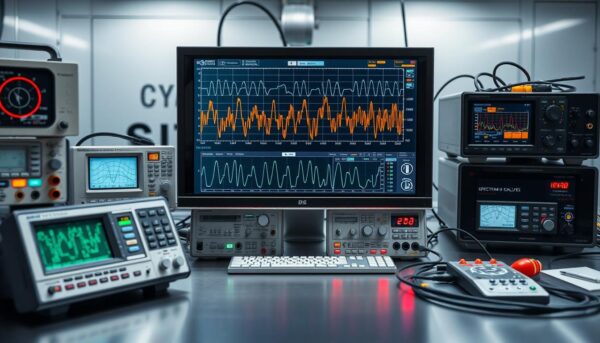✅ Last checked on
Ever wondered why your Wi-Fi slows down or your phone calls drop? Signal interference might be the reason. With more wireless tech, keeping connections clear is harder. But don’t worry, we’ve got you covered.
Signal interference is like an unwanted guest at your party. It messes with your conversations and causes trouble. More wireless devices in our spaces make it worse. Did you know microwaves can cut your Wi-Fi speed by half? Or that thick walls and furniture can weaken your signal?
This guide will teach you how to spot and fix signal interference. We’ll look at what causes those annoying drops and slow speeds. You’ll learn how to make your wireless setup better, from simple router tricks to advanced monitoring. By the end, you’ll know how to keep your devices running smoothly, without interference.
Key Takeaways
- Signal interference can significantly impact wireless performance
- Common sources include other electronic devices and physical obstacles
- Proper router placement can greatly improve signal strength
- Regular monitoring helps detect and address interference issues
- Understanding different frequency bands aids in optimizing connections
- Simple changes can lead to substantial improvements in wireless stability
Understanding Radio Frequency Interference Basics
Radio frequency interference (RFI) is a big problem in our wireless world. With 5G and more IoT devices, we’re dealing with a lot of digital data. This is causing a lot of congestion in the upper RF spectrum, making it key to optimize wireless signals.
What is Signal Interference
Signal interference happens when unwanted radio waves mess with our communications. It can come from natural things like storms or from devices we make. RFI affects frequencies from 3 kHz to 300 GHz, impacting many technologies.
Common Types of RF Interference
RF interference has many forms. Co-channel interference is when many signals use the same frequency. Adjacent-channel interference is between nearby frequencies. Non-WiFi radio interference comes from many electronic devices. Each type needs its own way to deal with it.
Impact on Various Industries
RFI affects many sectors:
- Telecommunications: Less network coverage and capacity
- Aviation: Safety risks from more drones
- Military: Trouble detecting unauthorized signals
- Electrical Engineering: Need for better interference detection
In cellular networks, RFI can cause crackling sounds, dropped calls, and slow speeds. To fix this, industries are using 24/7 spectrum monitoring and automated wideband interference detection.
| Industry | RFI Impact | Mitigation Approach |
|---|---|---|
| Telecommunications | Reduced QoS, dropped calls | Continuous KPI monitoring |
| Aviation | Safety risks from drones | Enhanced signal detection |
| Military | Operational security threats | Advanced RF monitoring |
Sources of Signal Interference in Modern Environment
In today’s world, signal interference can mess up important communications. Knowing where these problems come from is crucial. It helps keep electromagnetic compatibility strong and ensures signals are clear.
WiFi and Cellular Network Interference
WiFi and cell networks often fight each other in crowded places. This can hurt public safety messages, like those for land mobile radio, LTE, and GPS. To fix this, groups need to make PACE plans.
Electronic Device Interference
Many electronic devices can cause signal problems:
- Microwave ovens
- Vehicle ignition systems
- Nearby wireless transmitters
- Jamming devices
These can mess up important calls, like 911 and first responder talks. Using signal filters is key to solving these issues.

Environmental and Structural Interference
Nature and buildings can also block signals:
- Lightning and solar flares
- Dense walls and metal surfaces
- Large bodies of water
To keep communications strong, public safety teams need to know about RF interference. They must be ready for both accidental and intentional problems. This knowledge is essential for keeping our communication systems working well.
Signal Detection and Measurement Tools
Effective spectrum management and interference suppression need precise tools. These tools help find and fix problems in wireless communications. They ensure top performance across various frequencies.
Spectrum Analyzers and Their Uses
Spectrum analyzers show RF signals across different frequencies. They cover from 3 kHz to 110 GHz, covering RF, microwave, and mmWave bands. These tools measure signal strength and report important details like S11 and S21 in decibels or decibel-milliwatts.

Signal Strength Monitoring Equipment
Equipment for monitoring signal strength is key for checking wireless connection quality. For mobile base station testing, engineers use two handheld RF analyzers. One has a gain-horn antenna, and the other an omnidirectional antenna for real-time analysis.
Software-Based Detection Solutions
Software solutions give real-time insights into network performance. They are great for analyzing complex modulation schemes like orthogonal frequency division multiplexing. This scheme boosts mobile subscriber capacities in wireless systems.
| Tool | Effectiveness | Primary Use |
|---|---|---|
| Direction-Finding Techniques | 50% in practical deployments | Locating last-mile interference |
| Manual Signal Triangulation | 25% improvement over automated systems | Enhancing detection rates |
| Directional Antenna | 30% enhancement in capabilities | RF testing and signal detection |
Using these advanced tools and techniques helps accurately find and solve interference problems. This makes it easier to keep wireless communication at its best.
How to Resolve Signal Interference
Dealing with signal interference needs smart plans and tech solutions. We’ll look at ways to boost your network and fight off interference.
Channel Selection and Frequency Management
Choosing the right channel is crucial to cut down on interference. In the U.S., routers use 11 channels in the 2.4 GHz band. Pick a less busy channel to avoid congestion. The 5 GHz band offers more channels and less interference, even if it’s shorter in range.
Using band-steering can guide devices to the 5 GHz band. This co-existence mechanism boosts your network’s performance.
Equipment Placement Strategies
Where you place your Wi-Fi router matters a lot. Keep it away from thick walls, metal, and water. These can weaken your signal.
Wi-Fi extenders can fix dead zones caused by physical barriers. For best coverage, aim for a 15-20% overlap between access points.
Shielding and Isolation Techniques
Shielding can be a powerful tool against interference. Radio attenuating paints, costing about $250 for a 5-liter bucket, can isolate signals. For a cheaper option, use Ethernet cables to cut down on wireless traffic.
Dynamic beamforming is also effective. It focuses Wi-Fi signals and steers them around interference. This improves your signal-to-noise ratio without lowering data rates.
| Signal Level (dBm) | SNR (dB) | Performance |
|---|---|---|
| -30 | 65 | Excellent |
| -67 | 28 | Very Reliable |
| -70 | 25 | Reliable |
| -80 | 15 | Basic, Unreliable |
| -90 | 10 | Unlikely to Function |
By using these strategies, you can achieve a stronger, cleaner wireless signal. Regular checks with tools like RF spectrum analyzers will help you stay on top of interference.
Signal Optimization Best Practices
Mastering Wireless Signal Optimization is key to maintaining a robust network. By implementing effective Interference Suppression Methods, you can significantly enhance your network’s performance. Let’s explore some best practices to keep your wireless signals strong and interference-free.
Regular network audits are crucial for identifying potential issues before they escalate. These audits help you spot weak spots in your network and address them promptly. Use tools like spectrum analyzers to monitor signal strength and detect interference sources.
Optimizing your router settings can make a big difference. Adjust transmit power to balance coverage and interference. Enable features like beamforming to focus signals directly to your devices, improving reception and reducing interference.
For larger spaces, consider using mesh network systems or WiFi extenders. These solutions can help eliminate dead zones and provide consistent coverage throughout your area. By strategically placing these devices, you can create a seamless network that’s less prone to interference.
Key Metrics for Network Performance
| Metric | Importance | Optimization Goal |
|---|---|---|
| Latency | Critical for real-time apps | Minimize delays |
| Throughput | Determines data transfer capacity | Maximize for efficiency |
| Packet Loss | Affects VoIP and video quality | Reduce to near-zero |
| Jitter | Impacts streaming stability | Minimize for smooth playback |
Remember to keep your network devices updated with the latest firmware. This ensures compatibility with new technologies and improves security. By following these best practices, you’ll create a more reliable and efficient wireless environment that’s less susceptible to interference issues.
Preventive Measures and Long-term Solutions
Effective spectrum management and co-existence mechanisms are key for a reliable wireless network. By taking preventive steps and finding long-term solutions, you can reduce signal interference. This helps optimize your network’s performance.
Regular Signal Monitoring Protocols
Setting up regular monitoring protocols is crucial. Automated wideband interference detection equipment can monitor your spectrum 24/7. This helps you build a detailed signal library and understand your data better.
Infrastructure Planning Guidelines
When planning your wireless infrastructure, follow these guidelines to reduce interference:
- Use 802.11n or 802.11ac technology for better speed and performance
- Choose 5 GHz frequency bands to avoid common 2.4 GHz interference
- Place access points strategically to keep signal strength high
- Use directional antennas to focus RF energy and cut down on interference
Equipment Maintenance Standards
Regular maintenance of your equipment is vital for top performance. Follow these standards:
- Update your router’s firmware regularly to boost performance and security
- Replace old network adapters with USB wireless adapters for better communication
- Use wireless repeaters in big buildings to strengthen signals
- Buy equipment from the same manufacturer to improve compatibility
| Channel Utilization | User Experience |
|---|---|
| 0-20% | Optimal |
| 20-50% | Good |
| 50-80% | Degraded for VoIP and video |
| >80% | Reduced performance for all users |
By using these preventive measures and long-term solutions, you can make a stable wireless environment. This environment effectively manages spectrum and supports co-existence among different devices and networks.
Conclusion
Resolving signal interference is key for better wireless signals. GPS signal problems can lead to big errors. A small error can cause a big mistake over long distances. Good GPS receivers help fight these issues.
In LTE networks, managing interference is very important. Interference can slow down data speeds. Using the right power control helps keep the network running smoothly.
To fix signal problems, try differential correction and watch out for common causes. Things like blocked antennas and weather can cause issues. Also, remember that GPS jamming is illegal and harmful. By following this guide, you can improve your wireless signals and get better performance.